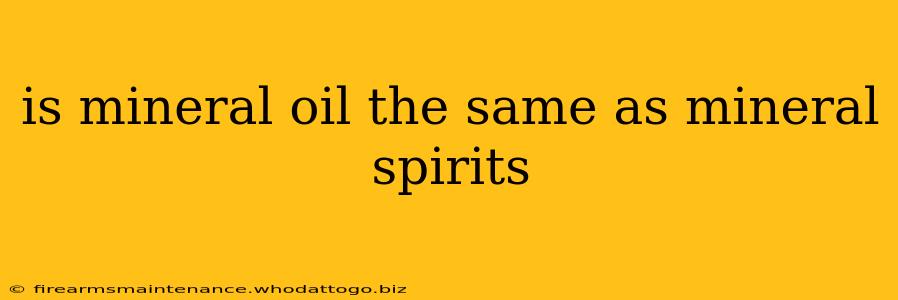Mineral oil and mineral spirits are both petroleum-derived liquids, leading to common confusion about their similarities and differences. However, these two substances have distinct chemical compositions, properties, and uses, making them entirely different products. This article will delve into the specifics of each, clarifying their key distinctions and helping you understand when to use each one.
Understanding Mineral Oil
Mineral oil, also known as liquid paraffin, is a colorless, odorless, and tasteless hydrocarbon mixture. It's a byproduct of petroleum refining, specifically the distillation of crude oil. Its primary characteristic is its inertness – it doesn't react readily with other chemicals. This makes it safe for many applications, although its precise composition can vary depending on the refining process.
Key Properties of Mineral Oil:
- Non-toxic (generally): While generally considered non-toxic when used externally in small amounts, ingestion should be avoided. Always follow product instructions.
- Non-irritating (generally): It's rarely irritating to the skin, making it suitable for some cosmetic and pharmaceutical applications.
- High viscosity: It's thicker and more viscous than mineral spirits.
- Insoluble in water: It doesn't mix with water.
- Applications: Common uses include laxatives, lubricants, cosmetics (e.g., baby oil), and as a processing aid in food manufacturing.
Understanding Mineral Spirits
Mineral spirits, also known as white spirits or petroleum spirits, is a clear, colorless liquid solvent derived from petroleum. Unlike mineral oil, it's a complex mixture of aliphatic and aromatic hydrocarbons, designed to dissolve fats, oils, and resins. Its primary function is as a cleaning agent and thinner for paints and varnishes.
Key Properties of Mineral Spirits:
- Flammable: Mineral spirits are highly flammable and should be handled with care away from open flames or sparks.
- Strong solvent: It dissolves many organic substances effectively.
- Volatile: It evaporates relatively quickly.
- Toxic (inhalation): Inhalation of mineral spirits fumes can be harmful and should be avoided. Always use in well-ventilated areas.
- Applications: Primarily used as a cleaning solvent for paints, brushes, and tools; as a thinner for paints and varnishes; and in some industrial processes.
Key Differences Summarized:
| Feature | Mineral Oil | Mineral Spirits |
|---|---|---|
| Chemical Composition | Primarily saturated hydrocarbons | Mixture of aliphatic and aromatic hydrocarbons |
| Viscosity | High | Low |
| Flammability | Low | High |
| Toxicity | Generally non-toxic (external use) | Toxic (inhalation) |
| Primary Use | Lubricant, cosmetic, laxative | Solvent, paint thinner |
| Odor | Odorless | Mild odor |
Conclusion: Absolutely Not the Same!
Mineral oil and mineral spirits are distinctly different substances with contrasting properties and applications. Confusing the two can have serious consequences, especially regarding safety and the intended use. Always carefully read labels and safety instructions before handling either product. Understanding their key differences is crucial for safe and effective use in various contexts.

